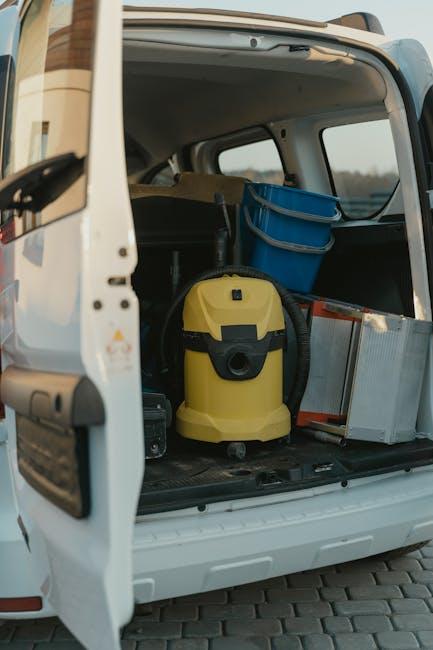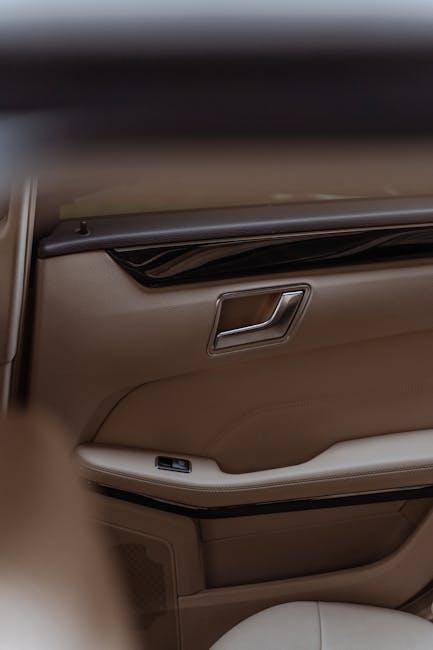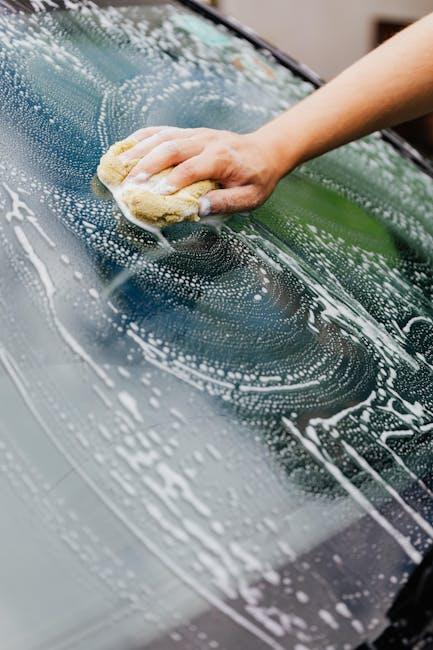Your car is more than just a means of transportation—it’s a personal space where countless memories are made, from road trips to daily commutes. Over time, however, those trusty car seats inevitably collect dirt, spills, and unexpected stains that can dull their appearance and compromise comfort. While professional cleaning services offer a solution, they can often be costly and time-consuming. That’s where DIY car seat cleaning hacks come in—simple, effective methods using everyday household items to refresh your seats and restore that like-new feel. Whether you’re tackling stubborn stains or just looking to maintain a spotless interior, this guide will equip you with easy, practical tips to keep your car seats looking their best without breaking the bank.
Table of Contents
- The Ultimate Guide to Preparing Your Car Seats for Deep Cleaning
- Eco-Friendly Solutions for Tackling Stubborn Stains
- Step-by-Step Techniques to Revive Fabric and Leather Seats
- Essential Tools and Supplies for Efficient DIY Cleaning
- Preventive Tips to Keep Your Car Seats Spotless Longer
- How to Safely Remove Odors and Maintain Freshness
- Q&A
- Concluding Remarks

The Ultimate Guide to Preparing Your Car Seats for Deep Cleaning
Before diving into a deep clean, start by thoroughly vacuuming your car seats to remove loose debris and dirt particles. Use a crevice tool for seams and folds where crumbs and dust tend to accumulate. For fabric seats, consider using a soft-bristle brush to gently lift dirt. Leather seats require a damp microfiber cloth to wipe away surface dust, followed by a leather-safe cleaner. Remember to test any cleaning solution on a small, hidden area first to avoid discoloration or damage.
Next, gather the essential tools and homemade cleaning solutions to tackle stains and grime effectively. Here’s a quick checklist of DIY essentials to have on hand:
- Baking soda – great for deodorizing and lifting stains
- White vinegar diluted with water – acts as a natural disinfectant
- Mild dish soap – ideal for breaking down grease and dirt
- Soft microfiber cloths – gentle on fabrics and leather
- Soft-bristle brush – helps agitate stains without damage
| Seat Type | Recommended Cleaner | Drying Time |
|---|---|---|
| Fabric | Baking soda paste & vinegar spray | 2-3 hours (air dry) |
| Leather | Leather conditioner & mild soap solution | 1-2 hours (avoid direct sunlight) |
| Vinyl | Dish soap & water mixture | 1-2 hours (towel dry) |

Eco-Friendly Solutions for Tackling Stubborn Stains
When it comes to deep-seated stains, turning to nature’s pantry can provide surprisingly effective results without harsh chemicals. White vinegar is a champion for breaking down dirt and neutralizing odors—mix equal parts with water, spray lightly on the fabric, and blot with a microfiber cloth. Baking soda works wonders, too; sprinkle it generously on the stain, let it sit for 15 minutes, then vacuum away the residue to absorb moisture and eliminate smells. For tougher grime, a combination of mild castile soap and warm water can gently lift dirt without damaging delicate upholstery.
- Lemon juice: Natural bleaching agent; apply carefully to avoid discoloration.
- Hydrogen peroxide (3%): Use sparingly on light-colored fabrics as a spot cleaner.
- Essential oils (tea tree or lavender): Add a few drops to cleaning solutions for antimicrobial benefits and fresh scent.
| Eco Solution | Best For | Application Tip |
|---|---|---|
| White Vinegar & Water | Odor and light stains | Light mist, blot, then air dry |
| Baking Soda | Moisture & odor absorption | Sprinkle, wait, vacuum |
| Castile Soap | Grease and grime | Mild scrub with soft brush |

Step-by-Step Techniques to Revive Fabric and Leather Seats
Begin by vacuuming every nook and cranny of your seats, ensuring all dust and loose dirt are removed. For fabric seats, mix a gentle upholstery cleaner with warm water and apply using a soft brush in circular motions. Avoid soaking the fabric to prevent mold growth. Wipe off excess moisture with a microfiber cloth, then let the seats air dry completely. For stubborn stains, create a paste from baking soda and water, apply it to the spot, let it sit for 15 minutes, and then gently scrub before wiping clean.
Leather seats require a different touch — start with a cleaning solution made of equal parts vinegar and water or opt for a commercial leather cleaner. Use a soft cloth to massage the cleaner into the leather without saturating it. After cleaning, condition the leather with a high-quality cream or oil to restore its softness and prevent cracking. Remember to buff the leather with a dry cloth for a subtle shine. Below is a quick guide to ideal solutions and tools for each seat type:
| Material | Cleaner | Tools | Finishing Touch |
|---|---|---|---|
| Fabric | Upholstery cleaner or baking soda paste | Soft brush, microfiber cloth | Air dry completely |
| Leather | Vinegar-water mix or leather cleaner | Soft cloth | Leather conditioner and buff |

Essential Tools and Supplies for Efficient DIY Cleaning
Having the right tools and supplies at hand transforms car seat cleaning from a chore into an efficient and satisfying task. Start with microfiber cloths—they’re gentle on fabric and upholstery fibers, yet tough enough to lift dirt and grime. A soft-bristled brush is essential for loosening debris embedded between fabric weaves or leather crevices without causing damage. Next, invest in a quality spray bottle filled with DIY cleaners like a diluted vinegar solution or gentle soap mix, which provide a safe and effective cleanse. Don’t overlook a handheld vacuum with crevice tools to reach those hidden corners and seams where crumbs and dust settle.
For tackling persistent stains or odors, a small bucket with warm water and a sponge can be your best friend. Additionally, having baking soda on standby offers a natural deodorizing boost. Using these supplies in tandem encourages a thorough clean, streamlining your workflow and leaving your car seats looking refreshed and cared for. Consider keeping a compact kit with these essentials inside your vehicle for quick touch-ups on the go.
| Tool/Supply | Purpose | DIY Tip |
|---|---|---|
| Microfiber Cloth | Gentle wiping & drying | Use dry for dust, damp for stains |
| Soft-Bristled Brush | Loosening dirt in fabrics | Brush in circular motions |
| Spray Bottle | Applying homemade cleaner | Mix water & vinegar for fabric safe cleaner |
| Handheld Vacuum | Debris extraction from seams | Use crevice tool attachment |
| Baking Soda | Odor elimination | Sprinkle & let sit before vacuuming |

Preventive Tips to Keep Your Car Seats Spotless Longer
Maintaining the pristine condition of your car seats doesn’t have to be a chore. Start by incorporating simple habits that prevent dirt and stains from embedding deeply into the fabric. Consider using reusable seat covers that can be easily washed or wiped down after every trip. Keep a small, microfiber cloth and compact vacuum in your vehicle to quickly tackle spills and crumbs before they become a problem. Additionally, applying a fabric protector spray formulated for automotive seats creates an invisible shield, helping liquids bead off and reducing overall wear from daily use.
Another effective approach is to minimize the introduction of contaminants by implementing a few daily routines. Encourage passengers to avoid eating or drinking in the car to reduce accidental spills, and always remove shoes before getting in when possible. A small bin or organizer for trash and personal items can also keep clutter from accumulating and rubbing against upholstery, which can lead to premature fading or tearing. Below is a quick reference table highlighting key habits and their benefits:
| Preventive Habit | Benefit |
|---|---|
| Using Seat Covers | Protects original fabric from stains and wear |
| Regular Vacuuming | Removes dirt and debris before settling |
| Fabric Protector Spray | Repels liquids and reduces staining |
| No Food or Drink Rule | Minimizes chances of spills and stains |
| Organize Clutter | Prevents abrasion and fabric damage |

How to Safely Remove Odors and Maintain Freshness
Start by sprinkling a generous amount of baking soda over your car seats. This natural deodorizer absorbs unpleasant smells without the use of harsh chemicals. Let it sit for at least 15 minutes—or overnight for stubborn odors—and then vacuum thoroughly using a handheld or car vacuum cleaner. For fabric seats, consider lightly misting a mixture of equal parts water and white vinegar in a spray bottle over the surface. The vinegar neutralizes odors and evaporates quickly, leaving behind a fresh scent. Always test any cleaning solution on a small, inconspicuous area first to avoid discoloration or damage.
To keep your car seats smelling fresh for longer, use these simple habits:
- Use charcoal bags or odor-absorbing sachets under seats to trap moisture and odors.
- Wipe spills immediately with a damp cloth and mild detergent to prevent staining and lingering smells.
- Regularly air out your vehicle by opening windows or doors on dry, sunny days.
| Tip | Effectiveness | Frequency |
|---|---|---|
| Baking Soda Application | High | Weekly |
| Vinegar Misting | Medium | Monthly |
| Charcoal Bags | High | Every 2 Months |
Q&A
Q&A: DIY Car Seat Cleaning Hacks
Q1: Why should I clean my car seats myself instead of going to a professional?
A1: DIY car seat cleaning saves you money, lets you clean on your own schedule, and gives you control over the products you use—plus, it’s surprisingly satisfying to see immediate results from your own efforts!
Q2: What are some everyday household items that can help clean car seats?
A2: Common items like baking soda, white vinegar, dish soap, and even a soft toothbrush can be your best friends. Baking soda deodorizes, vinegar disinfects, and dish soap cuts through grime without harsh chemicals.
Q3: How do I tackle tough stains like coffee or grease on fabric seats?
A3: Start with a mix of equal parts white vinegar and water in a spray bottle. Lightly spray the stain, let it sit for 5-10 minutes, then gently scrub with a soft brush. Finish by blotting dry with a clean cloth. Repeat if needed!
Q4: What’s the best way to clean leather car seats without damaging them?
A4: Use a mild soap mixed with water to gently wipe the surface, then apply a leather conditioner to keep the material supple. Avoid harsh chemicals or abrasive scrubbing, which can cause cracks or discoloration.
Q5: Can baking soda really help with car seat odors?
A5: Absolutely! Sprinkle baking soda generously on the seats, leave it for several hours (or overnight for stubborn odors), and then vacuum thoroughly. It absorbs unwanted smells naturally and leaves your car fresher.
Q6: How often should I clean my car seats to keep them in good condition?
A6: A light cleaning every 1-2 months and a deep clean every 6 months will keep your seats looking sharp. Of course, spills call for immediate attention to avoid permanent stains.
Q7: Are there any quick hacks for last-minute car seat cleaning before guests arrive?
A7: Grab some baby wipes or makeup remover wipes for a quick surface clean. They’re great for wiping away dust, crumbs, and small spills in a flash!
Q8: Can I use a vacuum cleaner for car seats, and if so, what attachments work best?
A8: Yes! Use a crevice tool to reach tight spots and a brush attachment for fabric surfaces. This helps remove embedded dirt and debris without damaging your seats.
Q9: What should I avoid when cleaning car seats at home?
A9: Stay clear of bleach, ammonia-based cleaners, and abrasive brushes—they can ruin fabric fibers and leather finishes. Also, avoid soaking the seats; too much moisture can cause mold or mildew.
Q10: Are DIY car seat cleaning hacks effective long-term?
A10: When done regularly and carefully, DIY cleaning prolongs your car seats’ life and appearance. It also empowers you to maintain a pleasant and hygienic driving environment without breaking the bank.
Concluding Remarks
And there you have it—your go-to guide for transforming tired, grimy car seats into fresh and inviting comfort zones, all without breaking the bank or visiting the pros. With a little elbow grease and these savvy DIY hacks, your car can look and feel like new again. So roll up your sleeves, gather your supplies, and embark on your cleaning adventure—because a cleaner car seat is more than just a chore; it’s a small step toward reclaiming your ride’s pride and your peace of mind. Happy cleaning!


3 Comments
y9yrsg
y9yrsg
Выбирая надежную платформу, стоит обратить внимание на хостинг для хрумера, который обеспечивает бесперебойную работу.